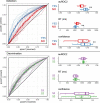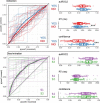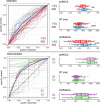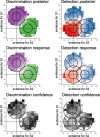Paradoxical evidence weighting in confidence judgments for detection and discrimination
- PMID: 37340214
- PMCID: PMC10584752
- DOI: 10.3758/s13414-023-02710-8
Paradoxical evidence weighting in confidence judgments for detection and discrimination
Abstract
When making discrimination decisions between two stimulus categories, subjective confidence judgments are more positively affected by evidence in support of a decision than negatively affected by evidence against it. Recent theoretical proposals suggest that this "positive evidence bias" may be due to observers adopting a detection-like strategy when rating their confidence-one that has functional benefits for metacognition in real-world settings where detectability and discriminability often go hand in hand. However, it is unknown whether, or how, this evidence-weighting asymmetry affects detection decisions about the presence or absence of a stimulus. In four experiments, we first successfully replicate a positive evidence bias in discrimination confidence. We then show that detection decisions and confidence ratings paradoxically suffer from an opposite "negative evidence bias" to negatively weigh evidence even when it is optimal to assign it a positive weight. We show that the two effects are uncorrelated and discuss our findings in relation to models that account for a positive evidence bias as emerging from a confidence-specific heuristic, and alternative models where decision and confidence are generated by the same, Bayes-rational process.
Keywords: Confidence; Detection; Metacognition.
© 2023. The Author(s).
Conflict of interest statement
The authors have no conflicting interests to declare.
Figures





















Similar articles
-
Modelling visibility judgments using models of decision confidence.Atten Percept Psychophys. 2021 Nov;83(8):3311-3336. doi: 10.3758/s13414-021-02284-3. Epub 2021 Jun 4. Atten Percept Psychophys. 2021. PMID: 34089166 Free PMC article.
-
Confidence in the Real World.Trends Cogn Sci. 2020 Aug;24(8):590-591. doi: 10.1016/j.tics.2020.05.005. Epub 2020 May 20. Trends Cogn Sci. 2020. PMID: 32446639
-
Distinct neural contributions to metacognition for detecting, but not discriminating visual stimuli.Elife. 2020 Apr 20;9:e53900. doi: 10.7554/eLife.53900. Elife. 2020. PMID: 32310086 Free PMC article.
-
Optimal metacognitive decision strategies in signal detection theory.Psychon Bull Rev. 2025 Jun;32(3):1041-1069. doi: 10.3758/s13423-024-02510-7. Epub 2024 Nov 18. Psychon Bull Rev. 2025. PMID: 39557811 Free PMC article. Review.
-
Visual Confidence.Annu Rev Vis Sci. 2016 Oct 14;2:459-481. doi: 10.1146/annurev-vision-111815-114630. Epub 2016 Aug 3. Annu Rev Vis Sci. 2016. PMID: 28532359 Review.
Cited by
-
A Population Representation of the Confidence in a Decision in the Parietal Cortex.bioRxiv [Preprint]. 2025 Feb 1:2024.08.15.608159. doi: 10.1101/2024.08.15.608159. bioRxiv. 2025. Update in: Cell Rep. 2025 Apr 22;44(4):115526. doi: 10.1016/j.celrep.2025.115526. PMID: 39229195 Free PMC article. Updated. Preprint.
-
Design and evaluation of crowdsourcing platforms based on users' confidence judgments.Sci Rep. 2024 Aug 8;14(1):18379. doi: 10.1038/s41598-024-65892-7. Sci Rep. 2024. PMID: 39112555 Free PMC article.
References
-
- Fechner, G. T., & Adler, H. E. (1860). Elemente der psychophysik [Elements of psychophysics]. Breitkopf and Ha Rtel.
MeSH terms
Grants and funding
LinkOut - more resources
Full Text Sources

